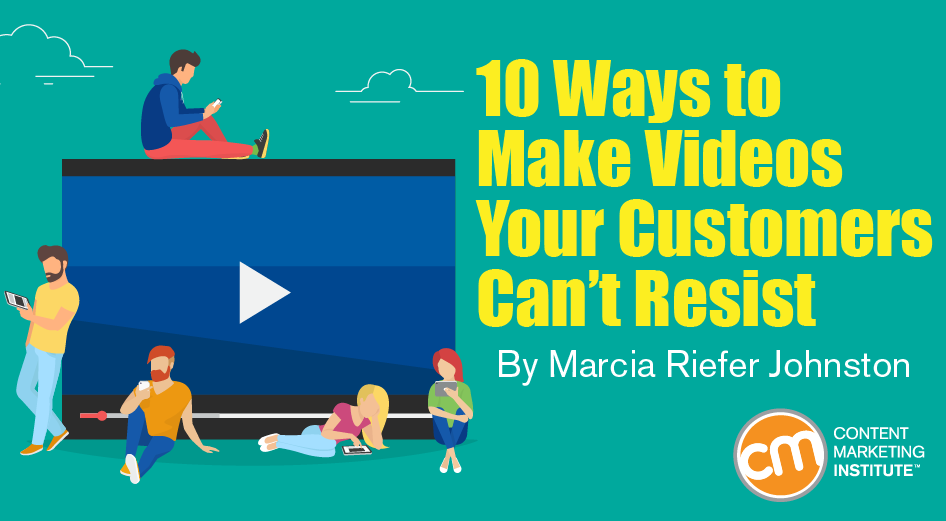In his Content Marketing World talk, How to Make Your Videos as Engaging as Possible, Matthew covers ways to make irresistible videos. Tell a story (including conflict) Give your videos a story structure. Here’s an example Matthew gives. One brand that got humor right, he says, is Kmart with this 2013 Ship My Pants commercial, which racked up some 13 million views on YouTube in one week. Pay attention to audio (even though some viewers won’t) Yes, lots of people watch videos with the sound off, but take care with what they’ll hear if they listen. I loved listening to him, but you want to keep things moving and changing. If you wait until the end and say, ‘Oh, now that we’ve made this video, we should have people fill out an email address,’ that doesn’t work. Follow through (to keep people engaged) After people see your video, then what? Conclusion These 10 points touch on only a portion of the advice that Matthew shares in his two talks at Content Marketing World. There’s no end to the ways that marketers can make videos engaging.

Maybe you know someone who has lost whole afternoons to YouTube. What is it about those videos that’s so hard to resist?
Matthew Pierce has some ideas. He’s a learning and video ambassador for TechSmith Corp., a company that makes visual-communication software. In his Content Marketing World talk, How to Make Your Videos as Engaging as Possible, Matthew covers ways to make irresistible videos. I touch on 10 of them here.
1. Tell a story (including conflict)
Give your videos a story structure. Matthew identifies story elements as setup, confrontation, and resolution. You may think of them as setting, conflict, and denouement. Rising action, climax, and falling action. Beginning, middle, and end.
However you think of your story structure, include conflict: tension, something at stake, something to overcome. Here’s an example Matthew gives.
2. Evoke emotion (appropriately)
While tugging at heartstrings can backfire, many of the most effective videos from brands include an emotional appeal. Think of the Super Bowl ads, Matthew reminded us. Are you picturing horses? Puppies? Babies?
This Budweiser commercial goes straight for the heart. The company clearly expected the audience to relate to the main character, a stranger in a sometimes unfriendly land, someone passionate about his vision for the future. Oh, and he loves beer. Meet Adolphus Busch.
Matthew offers a similar point made by Jodi Harris in this CMI article: “Video can convey an appropriate emotional tone in a way that text alone can’t manage.”
Matthew’s advice: Figure out which emotions make sense for your brand and for the purpose of your video, and plan accordingly. He mentioned his company, TechSmith, as an example:
I work for a software company. I don’t want people crying in association with my product. What I want them to feel is excited, accomplished, like ‘Man, look what I created. I can take on the world.’
3. Use humor (advisedly)
“Humor is hard,” Matthew says. “It doesn’t always go well. You’ve got to know your audience.” If you’ve ever told a joke that no one laughed at, you know what he’s talking about.
One brand that got humor right, he says, is Kmart with this 2013 Ship My Pants commercial, which racked up some 13 million views on YouTube in one week.
Getting the humor right – making people laugh – doesn’t guarantee business success, though. It’s not clear whether this video achieved its mandate: to boost the use of Kmart’s shipping service.
If you’re going to use humor, Matthew says, “make sure that it leads to customer action.” No matter how entertaining your video may be, if it doesn’t inspire people to do something in line with your strategy, its value to the company is questionable.
4. Pay attention to audio (even though some viewers won’t)
Yes, lots of people watch videos with the sound off, but take care with what they’ll hear if they listen. Bad audio can kill the experience of watching a video. And, Matthew says, it’s easy to get bad audio.
He has three main recommendations:
If you’re going to use music, unless you’re unusually talented at creating your own, buy it. And, because it so powerfully sets the tone, choose it with care. “Music has consequences,” Matthew says.
To illustrate the dramatic impact of music, Matthew points to an episode of the web show Film Riot, an online filmmaking-education series. This episode, How to Manipulate People With Music, delivers a short scene – one man handing another a package – twice in a row. Only the music changes. The music alone transforms the scene from “death time” to “sexy time.”
5. Use color intentionally (as filmmakers do)
How you use color can detract from or enhance people’s experience of your videos. For example, Matthew points out, the filming of O Brother, Where Art Thou? happened in Mississippi in the summer when everything was green. Since…

COMMENTS